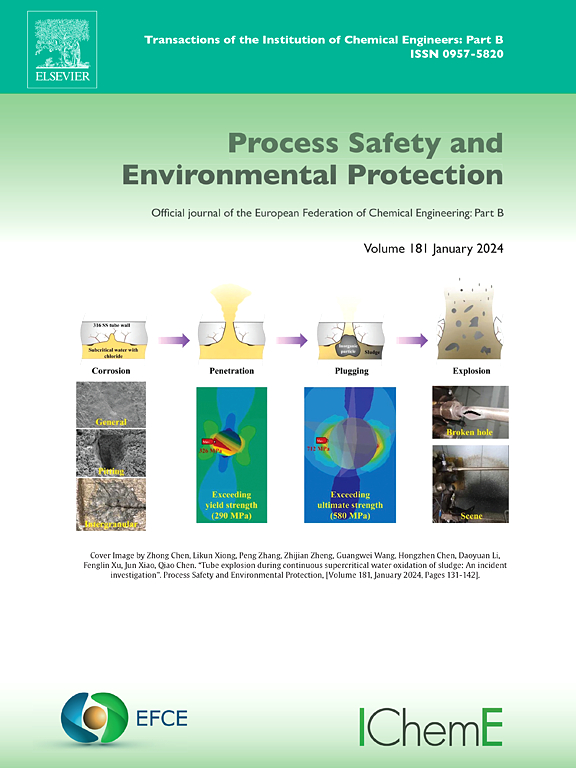Sustainable hydrogen production for ammonia from black liquor gasification integrated with modern pulp mills for carbon-neutral systems
IF 6.9
2区 环境科学与生态学
Q1 ENGINEERING, CHEMICAL
引用次数: 0
Abstract
Climate change mitigation and energy security serve as significant drivers for the development of innovative sustainable technologies aimed at evaluating diverse sustainability factors to achieve efficient future energy systems. With an established infrastructure, pulp and paper mills can concurrently produce bio-chemicals, biofuels, and electricity alongside pulp and paper products utilizing waste black liquor. This study highlights key sustainability aspects of hydrogen production leading to ammonia synthesis derived from various black liquor gasification systems integrated with modern pulp mills. The study is novel as it comprehensively presents the detailed aspects of black liquor as a sustainable feedstock, emphasizing its availability as a byproduct in the pulp and paper industry, along with its environmental benefits and includes a comparison of the key sustainability aspects of green ammonia production with traditional methods. Furthermore, the paper conducts an environmental impact assessment, analyzing the implications of such integration, encompassing aspects such as greenhouse gas emissions, air and water pollution, and other environmental factors. Economic viability and technological advancements are critically assessed, along with an exploration of the socio-economic and policy implications. From a technical perspective, the integrated catalytic hydrothermal gasification (CHG) system demonstrated the highest energy efficiency among studied systems but at a cost of highest additional biomass import to offset the energy deficit of the reference mill. The paper summarizes the key findings related to the sustainability aspects emphasizing its pivotal role in advancing sustainable energy transitions and reducing carbon emissions. The current study builds new knowledge on black liquor-based hydrogen production leading to ammonia synthesis to key stakeholders and contributes to understanding the potential for sustainable and environmentally friendly green chemical solutions.
从黑液气化可持续制氢氨与现代纸浆厂的碳中性系统集成
减缓气候变化和能源安全是开发创新可持续技术的重要驱动力,这些技术旨在评估各种可持续性因素,以实现高效的未来能源系统。随着基础设施的建立,纸浆和造纸厂可以同时生产生物化学品、生物燃料和电力,同时利用废黑液生产纸浆和造纸产品。这项研究强调了氢生产的关键可持续性方面,导致氨合成源于各种黑液气化系统与现代纸浆厂集成。这项研究是新颖的,因为它全面介绍了黑液作为可持续原料的详细方面,强调了它作为纸浆和造纸工业副产品的可用性,以及它的环境效益,并包括绿色氨生产与传统方法的关键可持续性方面的比较。此外,本文还进行了环境影响评价,从温室气体排放、大气和水污染等环境因素分析了一体化的影响。对经济可行性和技术进步进行严格评估,同时探索社会经济和政策影响。从技术角度来看,综合催化水热气化(CHG)系统在所研究的系统中表现出最高的能源效率,但其成本是最高的额外生物质进口,以抵消参考工厂的能源赤字。本文总结了可持续性方面的主要研究成果,强调了其在推进可持续能源转型和减少碳排放方面的关键作用。目前的研究为主要利益相关者提供了以黑酒为基础的氢气生产导致氨合成的新知识,并有助于了解可持续和环境友好型绿色化学解决方案的潜力。
本文章由计算机程序翻译,如有差异,请以英文原文为准。
求助全文
约1分钟内获得全文
求助全文
来源期刊

Process Safety and Environmental Protection
环境科学-工程:化工
CiteScore
11.40
自引率
15.40%
发文量
929
审稿时长
8.0 months
期刊介绍:
The Process Safety and Environmental Protection (PSEP) journal is a leading international publication that focuses on the publication of high-quality, original research papers in the field of engineering, specifically those related to the safety of industrial processes and environmental protection. The journal encourages submissions that present new developments in safety and environmental aspects, particularly those that show how research findings can be applied in process engineering design and practice.
PSEP is particularly interested in research that brings fresh perspectives to established engineering principles, identifies unsolved problems, or suggests directions for future research. The journal also values contributions that push the boundaries of traditional engineering and welcomes multidisciplinary papers.
PSEP's articles are abstracted and indexed by a range of databases and services, which helps to ensure that the journal's research is accessible and recognized in the academic and professional communities. These databases include ANTE, Chemical Abstracts, Chemical Hazards in Industry, Current Contents, Elsevier Engineering Information database, Pascal Francis, Web of Science, Scopus, Engineering Information Database EnCompass LIT (Elsevier), and INSPEC. This wide coverage facilitates the dissemination of the journal's content to a global audience interested in process safety and environmental engineering.
 求助内容:
求助内容: 应助结果提醒方式:
应助结果提醒方式:


